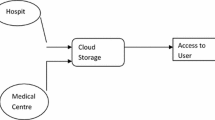Abstract
Wireless Capsule Endoscopy (WCE) is a technology in the field of endoscopic imaging which facilitates direct visualization of the entire small intestine. Many algorithms are being developed to automatically identify clinically important frames in WCE videos. This paper presents a supervised method for automated detection of bleeding regions present in WCE frames or images. The proposed method characterizes the image regions by using statistical features derived from the first order histogram probability of the three planes of RGB color space. Despite being inconsistent and tiresome, manual selection of regions has been a popular technique for creating training data in the studies of capsule endoscopic images. We propose a semi-automatic region-annotation algorithm for creating training data efficiently. All possible combinations of different features are exhaustively analyzed to find the optimum feature set with the best performance. During operation, regions from images are obtained by applying a segmentation method. Finally, a trained neural network recognizes the patterns of the data arising from bleeding and non-bleeding regions.








Similar content being viewed by others
References
Iddan, G., Meron, G., Glukhovsky, A., and Swain, P., Wireless capsule endoscopy. Nature 405:417, 2000.
Qureshi, W. A., Current and future applications of the capsule camera. Nat. Rev. Drug Discov. 3(5):447–450, 2004.
Hussain, H., Lapin, S., and Cappell, M. S., Clinical scoring systems for determining the prognosis of gastrointestinal bleeding. Gastroenterol. Clin. N. Am. 29(2):445–464, 2000.
Katz, L. B., The role of surgery in occult gastrointestinal bleeding. In: Seminars in Gastrointestinal Disease. Vol. 10, no. 2, pp. 78–81, 1999.
Triester, S. L., Leighton, J. A., Leontiadis, G. I., Fleischer, D. E., Hara, A. K., Heigh, R. I., Shiff, A. D., and Sharma, V. K., A meta-analysis of the yield of capsule endoscopy compared to other diagnostic modalities in patients with obscure gastrointestinal bleeding. Am. J. Gastroenterol. 100(11):2407–2418, 2005.
Lewis, B. S., and Swain, P., Capsule endoscopy in the evaluation of patients with suspected small intestinal bleeding: Results of a pilot study. Gastrointest. Endosc. 56(3):349–353, 2002.
Buscaglia, J. M., Giday, S. A., Kantsevoy, S. V., Clarke, J. O., Magno, P., Yong, E., and Mullin, G. E., Performance characteristics of the suspected blood indicator feature in capsule endoscopy according to indication for study. Clin. Gastroenterol. Hepatol. 6(3):298–301, 2008.
Fu, Y., Mandal, M., and Guo, G., Bleeding region detection in WCE images based on color features and neural network. In: Circuits and Systems (MWSCAS), 2011 I.E. 54th International Midwest Symposium on, pp. 1–4, 2011.
Pan, G., Yan, G., Qiu, X., and Cui, J., Bleeding detection in wireless capsule endoscopy based on probabilistic neural network. J. Med. Syst. 35(6):1477–1484, 2011.
Hwang, S., Oh, J., Cox, J., Tang, S. J., and Tibbals, H. F., Blood detection in wireless capsule endoscopy using expectation maximization clustering. In Proc. of SPIE, p. 61441P–61441P–11, 2006.
Li, B., and Meng, M. Q.-H., Computer-aided detection of bleeding regions for capsule endoscopy images. IEEE Trans. Biomed. Eng. 56(4):1032–1039, 2009.
Szczypiński, P., Klepaczko, A., Pazurek, M., and Daniel, P., Texture and color based image segmentation and pathology detection in capsule endoscopy videos. Comput. Methods Programs Biomed. 113(1):396–411, 2014.
Lee, Y.-G., and Yoon, G., Real-time image analysis of capsule endoscopy for bleeding discrimination in embedded system platform. World Acad. Sci. Eng. Technol. 59:2526–2530, 2011.
Sun, K., Wu, Y., Lin, X., Cheng, S., Zhu, Y.-M., and Zhang, S., Mean shift-based lesion detection of gastroscopic images. In: Intelligent Science and Intelligent Data Engineering. Springer, Heidelberg, pp. 167–174, 2012.
Sergyan, S., Color histogram features based image classification in content-based image retrieval systems In: Applied Machine Intelligence and Informatics, 2008. SAMI 2008. 6th International Symposium on, pp. 221–224, 2008.
Banu, M. S., and Nallaperumal, K., Analysis of color feature extraction techniques for pathology image retrieval system. In Computational Intelligence and Computing Research (ICCIC), 2010 I.E. International Conference on, pp. 1–7, 2010.
Sainju, S., Bui, F. M., and Wahid, K., Bleeding detection in wireless capsule endoscopy based on color features from histogram probability. In: Electrical and Computer Engineering (CCECE), 2013 26th Annual IEEE Canadian Conference on, pp. 1–4, 2013.
Ikonomakis, N., Plataniotis, K. N., and Venetsanopoulos, A. N., Color image segmentation for multimedia applications. J. Intell. Robot. Syst. 28(1–2):5–20, 2000.
Karargyris, A., and Bourbakis, N., Detection of small bowel polyps and ulcers in wireless capsule endoscopy videos. IEEE Trans. Biomed. Eng. 58(10):2777–2786, 2011.
Tseng, D. C., and Chang, C. H., Color segmentation using perceptual attributes. In Proceedings., 11th IAPR International Conference on Pattern Recognition. Vol. IV. Conference D: Architectures for Vision and Pattern Recognition, no. 1, pp. 228–231, 1992.
Lucchese, L., and Mitra, S. K., An Algorithm for Fast Segmentation of Color Images. Springer Verlag, London, pp. 110–119, 1999.
Umbaugh, S. E., Wei, Y.-S., and Zuke, M., Feature extraction in image analysis. A program for facilitating data reduction in medical image classification. Eng. Med. Biol. Mag. IEEE 16(4):62–73, 1997.
Bishop, C. M., Pattern Recognition and Machine Learning (Information Science and Statistics). Secaucus, NJ, USA: Springer-Verlag New York, Inc., pp. 227–228, 2006.
Theodoridis, S., and Koutroumbas, K., Pattern Recognition, Fourth. Academic Press, pp. 284–285, 2009.
The MathWorks, Inc. [Online]. Available: http://www.mathworks.com/.
capsuleendoscopy.org. [Online]. Available: http://www.capsuleendoscopy.org/Pages/default.aspx.
Faigel, D. O., and Cave, D. R., Capsule Endoscopy. Saunders Elsivier, Philadelphia, 2008.
Watt, E., MLIS, et al., Toward medical decision making. In: Alex, R. K. T., and Bui, A.T., (Ed.), Medical Imaging Informatics. Springer US, pp. 403–438, 2010.
Acknowledgments
This work was supported by Grand Challenges Canada (GCC) Star in Global Health and Natural Science and Engineering Research Council of Canada (NSERC). The authors would like to acknowledge Canada Foundation for Innovation (CFI) for providing the lab infrastructure and development tools.
Author information
Authors and Affiliations
Corresponding author
Additional information
This article is part of the Topical Collection on Systems-Level Quality Improvement
Rights and permissions
About this article
Cite this article
Sainju, S., Bui, F.M. & Wahid, K.A. Automated Bleeding Detection in Capsule Endoscopy Videos Using Statistical Features and Region Growing. J Med Syst 38, 25 (2014). https://doi.org/10.1007/s10916-014-0025-1
Received:
Accepted:
Published:
DOI: https://doi.org/10.1007/s10916-014-0025-1




